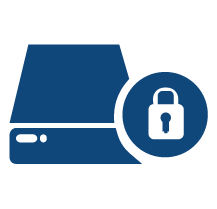Disk Encryption
Disk Encryption
 |
Whole disk encryption adds another layer of protection for your data if your computer is lost or stolen. |
What Disk Encryption Does
Whole disk encryption scrambles all of the data on your hard drive into gibberish. The information on your hard drive is only translated back into readable data when you provide a passcode or password to verify your identity. This provides another layer of protection in addition to login passwords.
Login passwords protect your data from most people who might want to access it maliciously. Even if you have a login password, it is still possible for a criminal to access your data if you don't have full disk encryption on your computer. For example, a criminal could remove your hard drive from your computer and plug it in to another computer to see your data.
If your hard drive is encrypted, you'll be prompted for your encryption passcode or password when you first power on your computer. Without the encryption passcode, your data remains completely encrypted and the computer will not turn on. This means criminals will not be able to access your information.
Disk Encryption for Windows
College-owned Windows computers use a product called BitLocker with a management product called MBAM (Microsoft BitLocker Administration and Monitoring). When BitLocker is enabled on your computer, you'll be required to set an encryption PIN that's separate from your NetID password.
When you power on your computer, you'll be asked to enter your PIN. After entering your PIN, your computer will finish starting up and you'll log in to your account with your NetID and password.
For the best protection, power off your computer overnight or while traveling.
If you forget your PIN, you can recover it in one of two ways:
- The BitLocker Self-Service Portal provides an online tool where you can gain access to your encrypted device.
- If you are unable to access the BitLocker Self-Service Portal you can contact us at ait.service.desk@wheaton.edu or call 630.752.4357 (HELP) for assistance.
Disk Encryption for macOS
College-owned macOS computers use a product called FileVault 2 with FileVault Management Tool.
Once FileVault 2 is enabled, your Mac will require you to enter your NetID password when you power it on and before the computer starts up.
If you forget your password and are unable to login to your Mac, contact us at ait.service.desk@wheaton.edu or call 630.752.4357 (HELP) for assistance.